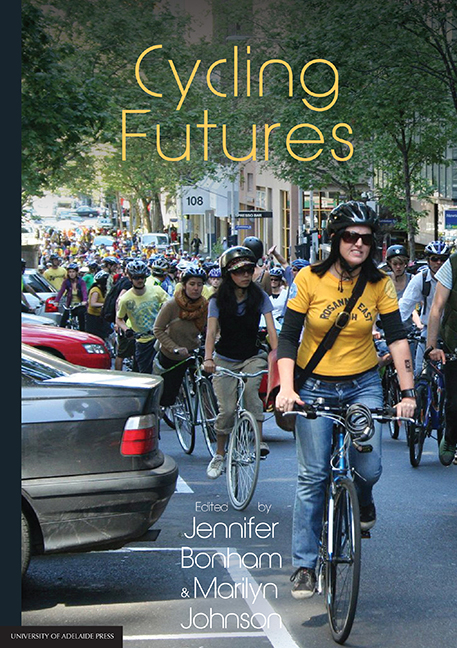Book contents
- Frontmatter
- Contents
- Preface
- Editors
- Contributors
- PART I Current challenges
- PART II Strategies for change
- 9 Gender and cycling: Gendering cycling subjects and forming bikes, practices and spaces as gendered objects
- 10 Making (up) the child cyclist: Bike Ed in South Australia
- 11 More than a message: Producing cyclists through public safety advertising campaigns
- 12 Spaces for cycling
- 13 Off-road cycling infrastructure
- 14 Teaching Australian civil engineers about cycling
- 15 What should planners know about cycling?
- 16 Skilling landscape architects and urban designers for design of bicycle parking and network facilities
- 17 Cycling and Australian law
12 - Spaces for cycling
from PART II - Strategies for change
Published online by Cambridge University Press: 25 July 2017
- Frontmatter
- Contents
- Preface
- Editors
- Contributors
- PART I Current challenges
- PART II Strategies for change
- 9 Gender and cycling: Gendering cycling subjects and forming bikes, practices and spaces as gendered objects
- 10 Making (up) the child cyclist: Bike Ed in South Australia
- 11 More than a message: Producing cyclists through public safety advertising campaigns
- 12 Spaces for cycling
- 13 Off-road cycling infrastructure
- 14 Teaching Australian civil engineers about cycling
- 15 What should planners know about cycling?
- 16 Skilling landscape architects and urban designers for design of bicycle parking and network facilities
- 17 Cycling and Australian law
Summary
Introduction
Across Australasia (and indeed the world) the debate has long continued about how to best provide for cycling. Leaving aside for now issues such as cycling promotions, driver behaviour and relevant legislation, which are covered in other chapters of this volume, the physical infrastructure and spaces provided play a crucial role in ensuring that existing people cycling have adequate levels of service (thus preventing further declines in numbers) whilst also attracting more people to choose to cycle.
High traffic speeds and volumes, as well as poor cycling facilities, are often identified as key deterrents to cycling in areas of relatively low cycling usage like Australasia. There is also some tension between those who want separated (often off-road) cycle facilities and those who prefer ‘integrated’ (on-road) facilities. The state of the art of professional guidance in this part of the world is still rapidly evolving; even the latest Austroads guidelines (Austroads, 2014) do not reflect some of the most recent developments elsewhere or guidance from countries demonstrating the world's best practice in cycling (for example, Centre for Research & Contract Standardisation in Civil Engineering [CROW], 2007, in the Netherlands).
This chapter provides some reflections on these issues, based on current research and practice in this area. It will focus particularly on on-road spaces for cycling.
Terminology
Before continuing the discussion, it is useful to clarify some of the terminology being used. Cycle facilities are often called by various names, which can lead to confusion by both practitioners and the general public alike about what exactly is being referred to. Lieswyn et al. (2012) provided a useful breakdown of cycling facility types, with the following key points:
• ‘Cycleway’ is generally an all-encompassing term for describing all types of dedicated cycling facilities.
• ‘Cycle lane’ describes an on-road cycling facility, often denoted only by road markings. A variation of this is a ‘protected’ or ‘segregated’ cycle lane, where cycles and motorised traffic are separated by some form of physical divider.
- Type
- Chapter
- Information
- Cycling Futures , pp. 251 - 282Publisher: The University of Adelaide PressPrint publication year: 2015



